Chilled water systems connect all equipment using chilled water pipes. Without using sophisticated software, how to size chilled water pipes with a chart?
In the following, I’ll share how I size chilled water pipes using the Closed Pipe System Friction Loss Chart by Carrier. I’ll be using a friction loss of 8 ft of water per 100 ft and a velocity of 10 ft per second to size chilled water pipe.
Notice that I’m using the chart for closed piping systems because the chilled water pipe in the chiller and air conditioner is closed-loop.
However, in my opinion, the resulting chilled water pipe size should be taken as a reference rather than an absolute because we need to consider the price of chilled water pipes and optimize the final chilled water pipe size.
How to Read the Friction Loss Chart?
We’ll be using all 4 elements in the friction loss chart to size chilled water pipes. Following, I’ll explain each of them and how we’re going to use them.
Friction Loss: How much resistance to the chilled water?
Friction loss is the amount of resistance exerted on the chilled water due to contact with the inner surface of the chilled water pipes. In other words, friction loss tells us how much distance the chilled water is not able to travel due to the friction.
Friction loss is expressed in feet of water per 100 feet. The unit of measurement for friction loss tells us how many feet of distance is lost for every 100 feet. For instance, a friction loss of 8 ft of water per 100 ft means that the chilled water travels 8 ft lesser for every 100 ft it travels.
Smaller pipes generally have higher friction loss. A high friction loss water cooling system requires higher pumps head to push the chilled water around and thus, higher pump costs. Contrarily, a low friction loss water cooling system requires bigger chilled water pipes and thus, higher pipe cost. Therefore, we need to strive for a balance point.
“A recirculating system is sized to provide a reasonable balance between increased pumping horsepower due to high friction loss and increased piping first cost due to large pipe sizes. In large air conditioning applications, this balance point is often taken as a maximum friction rate of 10 ft of water per 100 ft of equivalent pipe length.”
Carrier Air Conditioning System, Since 1915
Carrier recommended the friction loss of not more than 10 ft of water per 100 ft. I practice using not more than 8 ft of friction loss when sizing chilled water pipes.
Flow: How much chilled water flows inside the chilled water pipe?
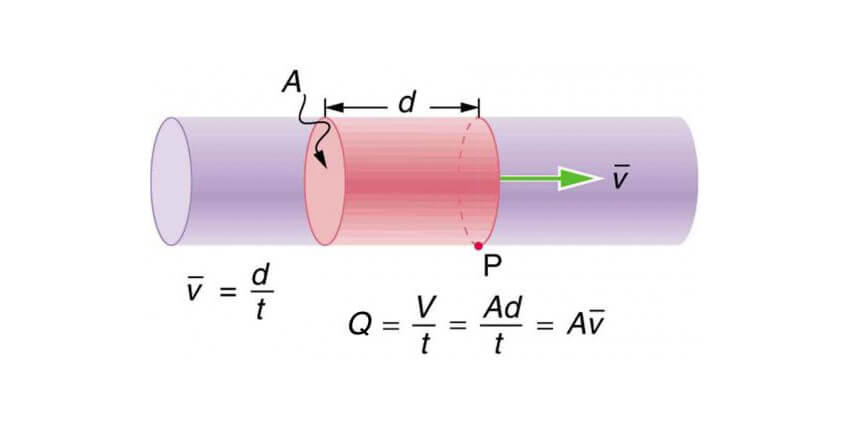
Flow or chilled water flow rate is the amount of water volume required to travel inside chilled water pipes. Flow is expressed in gallons per minute (GPM). It is not hard to understand that pipes need to be sized based on water flow rate.
Every chiller has a required chilled water flow rate for its rated cooling capacity. Generally, the lower the chilled water flow rate, the lower the cooling capacity. Thus, we need to size the chilled water pipes based on the amount of chilled water required for each chiller. The required chilled water flow rate usually can be found in the specification of your chiller.
When it comes to sizing for the chilled water pipe header, we simply add all the associated chilled water flow rates and use the chart again to find the corresponded pipe size.
Velocity: How fast is the chilled water moving inside the chilled water pipe?
| Pipe Size (in) | Flow | Velocity | Pressure Drop | |||
|---|---|---|---|---|---|---|
| (US GPM) | (liter/s) | (ft/s) | (m/s) | (ftH2O/100 feet) | (Pa/100 m) | |
| 4 | 140 | 9 | 3.5 | 1.1 | 2.2 | 21827 |
| 6 | 380 | 24 | 4.2 | 1.3 | 1.9 | 18877 |
| 8 | 650 | 41 | 4.2 | 1.3 | 1.4 | 13371 |
| 10 | 1100 | 69 | 4.2 | 1.3 | 1.2 | 11700 |
| 12 | 1800 | 114 | 4.5 | 1.4 | 1.2 | 12093 |
| 14 | 2200 | 139 | 5.1 | 1.6 | 1.1 | 11208 |
| 16 | 3300 | 208 | 5.9 | 1.8 | 1.2 | 11405 |
| 18 | 4500 | 284 | 6.2 | 1.9 | 1.2 | 11503 |
| 20 | 6000 | 379 | 6.7 | 2.0 | 1.2 | 11503 |
| 24 | 11000 | 694 | 7.8 | 2.4 | 1.2 | 11700 |
| 30 | 19000 | 1199 | 8.7 | 2.6 | 1.1 | 10913 |
| 3 | 70 | 4 | 3.0 | 0.9 | 2.3 | 22712 |
Main Pipes – maximum allowable flow, velocity, and pressure drop
Velocity is the velocity of the chilled water when traveling inside chilled water pipes. Velocity is expressed in feet per second (fps). We need to consider how fast the chilled water moves inside chilled water pipes. The faster the chilled water travels inside chilled water pipes, the quicker the erosion on the chilled water pipes and thus, the shorter the lifespan of the chilled water pipes.
In general, the faster the chilled water move, the shorter the lifespan of the chilled water pipe. I practice using not more than 10 fps for the velocity of chilled water.
Pipe Size: What is the resulted chilled water pipe size?
The resulting pipe size is expressed in inches. We can buy the standard-sized chilled water pipes from local chilled water pipe suppliers. There are no odd sizes such as 30mm, 60mm, and 70mm unless custom made.
Sizing Chilled Water Pipes Using a Friction Loss Chart
I suggest you print out the friction loss chart to ease the sizing process. In the following, I’ll provide step by step guide on how I size chilled water pipes using the friction loss chart:
Fix the Friction Loss of the Chilled Water
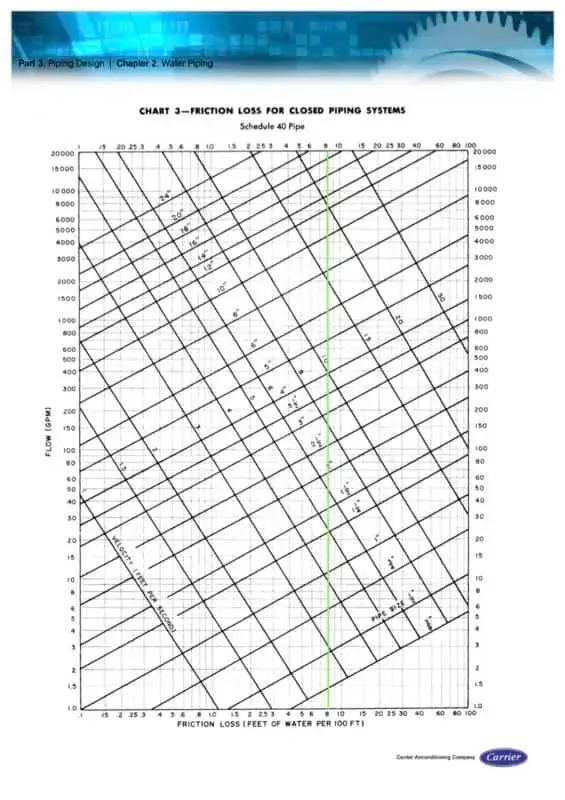
- The design criteria for the friction loss is not more than 8 ft.
- Highlight the friction loss axis at 8 ft.
Limit the Velocity of the Chilled Water
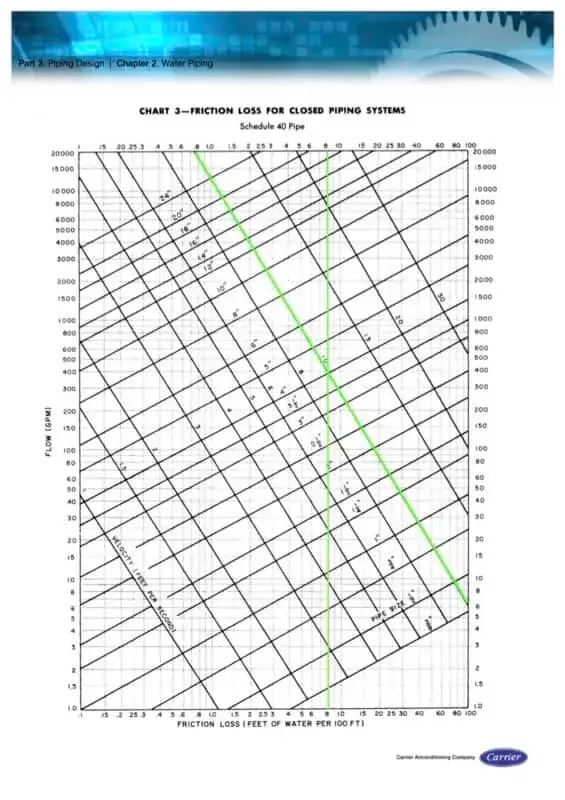
- The design criteria for the velocity is not more than 10 ft.
- Highlight the velocity axis at 10 ft.
Determine the Chilled Water Pipe Size
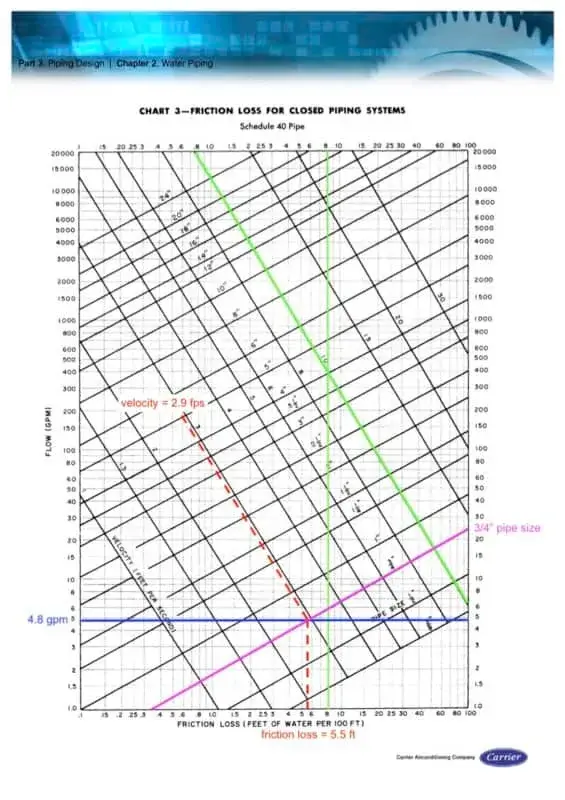
- Pull the horizontal line for the flow at 4.8 GPM (blue line) and find the pipe size within the design criteria.
- For this example, I get a 3/4″ pipe size (pink line). I check both the friction loss and velocity which are 5.5 ft and 2.8 fps respectively.
- Both the friction loss and velocity are well within the design criteria. Thus, a 3/4″ pipe size is suitable.
Optimize the Chilled Water Pipe Size
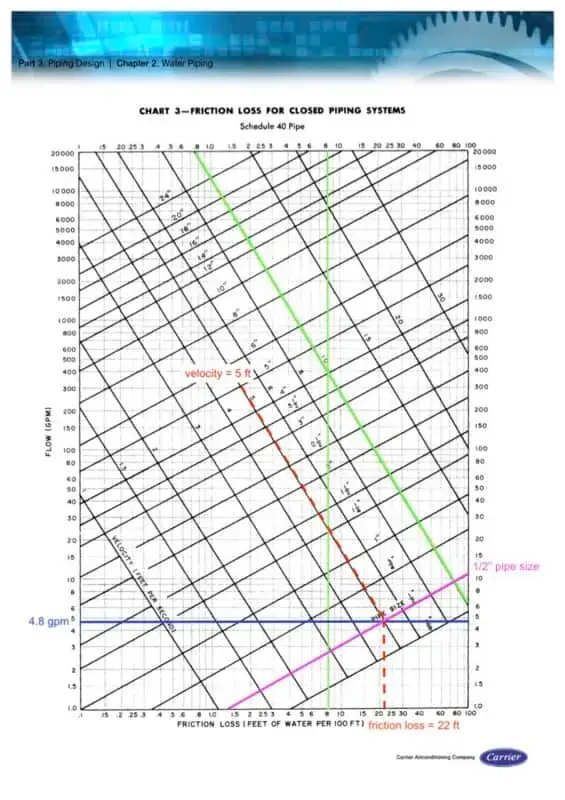
- Remember to always optimize the pipe size. Try a smaller pipe size in an effort to lower the pipe cost.
- For example, if I use a 1/2″ pipe size, I got the friction loss and velocity of 22 ft and 5 fps respectively.
- The friction loss is out of the design criteria and thus, a 1/2″ pipe size is not suitable.
- Therefore, the final chilled water pipe size is still 3/4″ for chilled water at a flow rate of 4.8 GPM.
Don’t Forget the Velocity when Sizing Big Pipes
Most of the time, friction loss is the primary factor when sizing chilled water pipes because small pipes are more common. Hence, we often forget that starting from around 400 GPM, velocity becomes the primary factor. Therefore, many people made the mistake including myself.
Be Flexible with the Chilled Water Pipe Size
Sometimes, you may get into a situation where there are two choices or the resulting pipe size is very close. In such cases, you often need to decide between performance, reliability and cost.
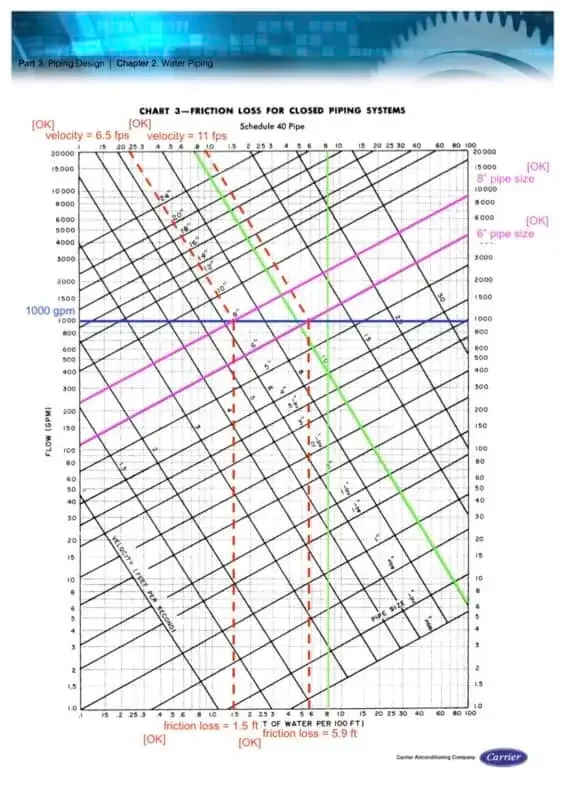
The above chart is an example of such a situation. For instance, if you are sizing a chilled water pipe for a 1,000 GPM flow of chilled water, you’ll get an 8″ pipe size with both the friction loss and velocity well under the design criteria. On the other hand, you may opt for a 6″ pipe size with a velocity of just a little over 10 fps.
If you ask me, I probably will go for a 6″ pipe size, especially when the velocity is just 1 fps more than the design criteria which is 10 fps, considering the cost.
Final Thought
As a general rule, the cost of chilled water pipes increase exponentially with the size due to not just material but insulation, jacketing, labor and logistic. One size bigger can be many times harder to install.
Another thing to consider is the pipe length. If the chilled water pipe length is relatively short and your pump has a surplus pump head, you may increase the allowable friction loss from 8 ft to 10 ft or more.
Similarly, if the chilled water pipe is very long, you may want to bring down the friction loss from 8 ft to 6 ft or less to ensure that the chilled water can reach the farthest air conditioner.

Straight to the point. Makes reading interesting. Continue to want more.
Thanks for your kind words, we will keep doing it.
Every hvac tech. need to read and learn from the various topics. Great content.
David, this article is perfect for basic chiller knowledge. It is a good idea to get in touch with your local chilled water pipe supplier or an industrial chiller company. This will help you tackle even the most sophisticated cooling needs of your facility. It keeps the equipment running smoothly regardless of the load or temperature.
Since, these days variable primary flow (VPF) system is familiar, what will be the optimum chart for flow, velocity and friction loss for CHW system. Pl advice.
HOLA, existe algun software que haga los calculos completos del circuito y dimensione la bomba?
Muy didáctico, no es algo nuevo pero se entiende de maravilla, que software se puede utilizar para saltar la imprecisión de los gráficos?, agradecido
Hola, existe algun software para dimensionamiento de tuberias y la red completa de la bomba?
Es la misma pregunta de marcelo bueno.Existe algun software para dimencionar tuberias y la red cmpleta de la bomba? Me pueden pasar los datos de Leon?
Lo sentimos, no disponemos de dicho software.